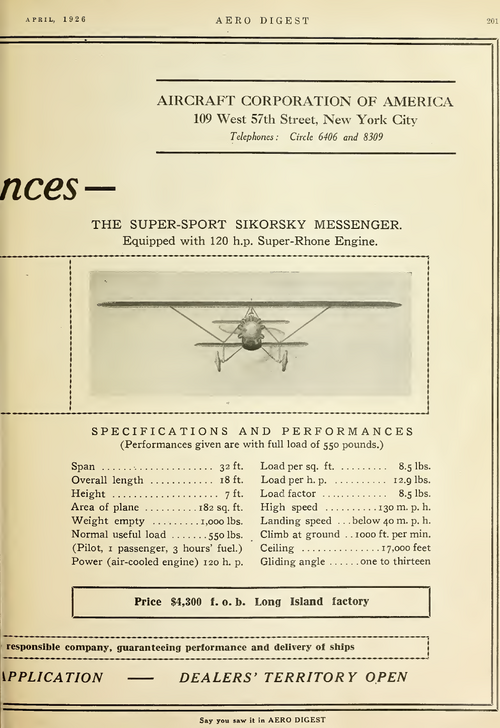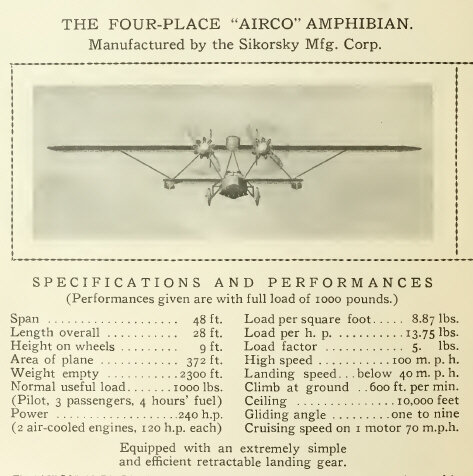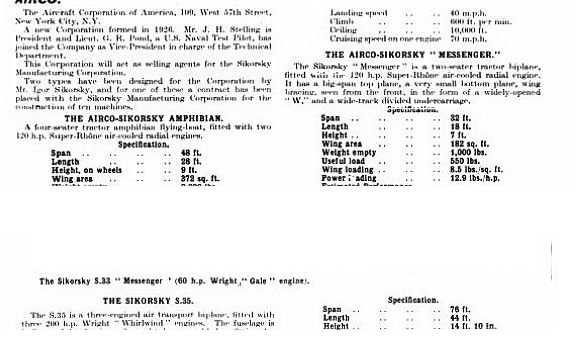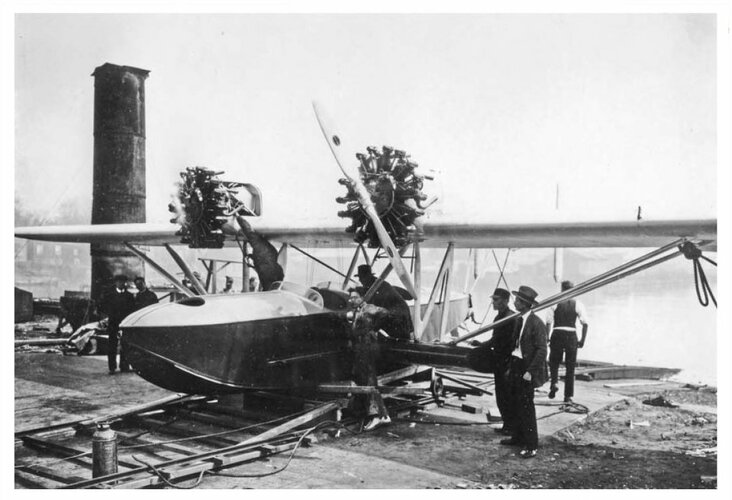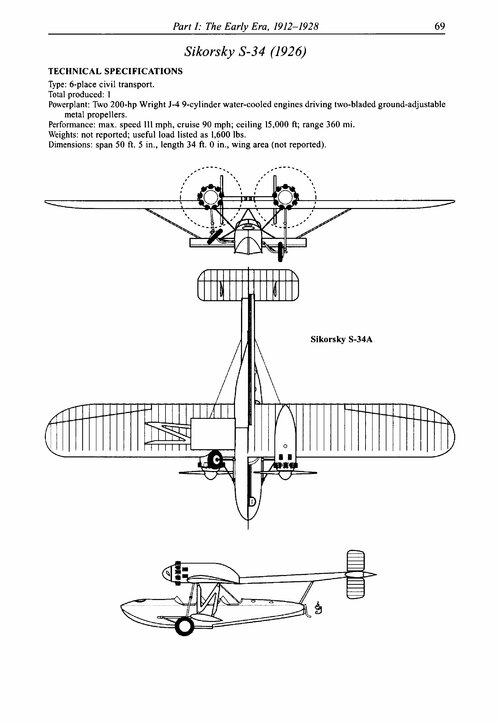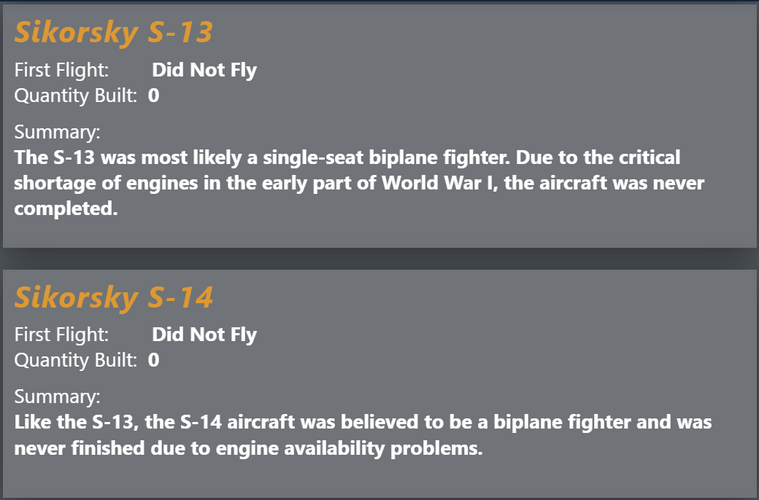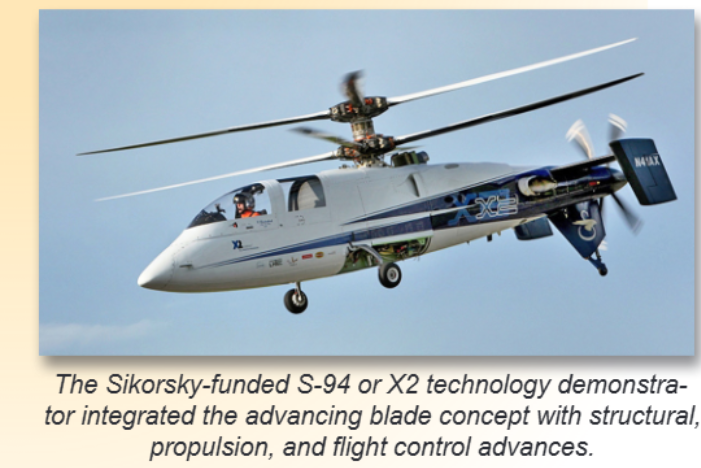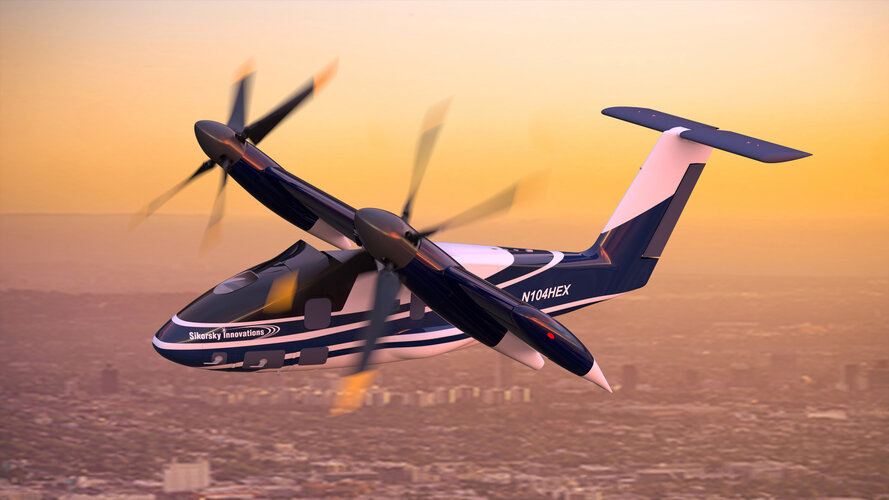You are using an out of date browser. It may not display this or other websites correctly.
You should upgrade or use an alternative browser.
You should upgrade or use an alternative browser.
Sikorsky models and designations
- Thread starter boxkite
- Start date
- Joined
- 25 June 2009
- Messages
- 14,731
- Reaction score
- 6,069
I shared this one elsewhere on the forum a few years ago, it's the Airco Messenger.From Aero Digest 1926,
what was this ?.
It was a smaller, four-seat version of the S-34 with two 120hp Super-Rhône engines and a simplified retractable gear. It was designed by Igor Sikorsky for the Aircraft Corp. of America (Airco), advertised in 1926, but not built.
Attachments
- Joined
- 25 June 2009
- Messages
- 14,731
- Reaction score
- 6,069
By the way, Airco was to act as selling agents for Sikorsky Manufacturing Corp., but the deal fell through.
Since the Airco "Messenger" was not pursued by Sikorsky, it didn't get an "S-" designation.
The Airco "Amphibian", of course, became the S-34.
Since the Airco "Messenger" was not pursued by Sikorsky, it didn't get an "S-" designation.
The Airco "Amphibian", of course, became the S-34.
Attachments
- Joined
- 26 May 2006
- Messages
- 34,820
- Reaction score
- 15,698
Hi,
S-77 was a design study for a Sikorsky variant
 sikorskyarchives.com
sikorskyarchives.com
S-77 was a design study for a Sikorsky variant
Helicopter Innovation Era – Igor I Sikorsky Historical Archives
 sikorskyarchives.com
sikorskyarchives.com
- Joined
- 26 May 2006
- Messages
- 34,820
- Reaction score
- 15,698
Attachments
- Joined
- 26 May 2006
- Messages
- 34,820
- Reaction score
- 15,698
The S-94
 sikorskyarchives.com
sikorskyarchives.com
Four Score at Sikorsky – Part 4: 2000 to 2020 – Igor I Sikorsky Historical Archives
 sikorskyarchives.com
sikorskyarchives.com
Attachments
- Joined
- 25 June 2009
- Messages
- 14,731
- Reaction score
- 6,069
Nice!The S-94
S-98: Advanced Commercial Rotorcraft
Source: https://www.linkedin.com/in/michael-devita-29275513/
S-90: mentioned in RAND report but possibly a typo.
Most of the key components of the CH-53X have been demonstrated, or are in production, including the engine (V-22), rotor and blades (S-90), and transmission (MI-26).
"S-96": several sites use that designation for VIP Helibus helicopters used by oil and gas companies transporting workers between locations, but it seems these are just typos for S-92.
Last edited:
- Joined
- 25 June 2009
- Messages
- 14,731
- Reaction score
- 6,069
Maveric
Fight for yor Right!
- Joined
- 14 January 2007
- Messages
- 2,227
- Reaction score
- 851
Is there a picture or a drawing of the S.98?Nice!
S-98: Advanced Commercial Rotorcraft
Source: https://www.linkedin.com/in/michael-devita-29275513/
S-90: mentioned in RAND report but possibly a typo.
"S-96": several sites use that designation for VIP Helibus helicopters used by oil and gas companies transporting workers between locations, but it seems these are just typos for S-92.
- Joined
- 25 June 2009
- Messages
- 14,731
- Reaction score
- 6,069
Unfortunately there is none! And since it was a 2010-2011 program we've never heard of, chances are it is now defunct and no pictures are likely to appear...Is there a picture or a drawing of the S.98?
- Joined
- 25 June 2009
- Messages
- 14,731
- Reaction score
- 6,069
I'm surprised to have found a mysterious Sikorsky aircraft type that I had never noticed before in the FAA listings...
Sikorsky Aircraft Corp. SZ 338B
My first thought was that "SZ 338B" could be related to the S330/S333 helicopters. Yet it couldn't be the Firefly electric demonstrator, since it was a single-engine, single-seater... And why "SZ" when the other former Schweizer models used a simple "S" designations?
Then another detail caught my eye: the letters "SB" at the end of both registrations, as in "Sikorsky Boeing". Could these registrations have been reserved (and not used) for the SB-1 Defiant? All the details correspond: two turboshaft engines, two seats...
However, the site AviationDB, which gives even more detail, claims that the SZ 338B was a "Fixed wing multi engine type"...
although Sikorsky hasn't built fixed-wing aircraft for over 80 years!
My best bet is that these two aircraft were never completed, despite the regs being reserved for them, but that doesn't make them any less mysterious! Ideas, anyone?
Sikorsky Aircraft Corp. SZ 338B
Another online source gives a more detailed account, which clearly gives it as a fixed-wing aircraft!
- N382SB, MSN 0001
Certificate Issue Date Oct 31, 2013
Mode S Code (base 8 / oct) 51062112
Mode S Code (base 16 / hex) A4644A
Cancel Date 03/13/2018
Reason For Cancellation Expiration
Export To None
Type Registration Corporation
- N385SB, MSN 0002
Certificate Issue Date Nov 1, 2013
Mode S Code (base 8 / oct) 51067557
Mode S Code (base 16 / hex) A46F6F
Cancel Date 03/13/2018
Reason For Cancellation Expiration
Export To None
Type Registration Corporation
Source: https://www.city-data.com/aircraft/air-Stratford-Connecticut.html
- Aircraft: SIKORSKY SZ 338B (Category: Land, Engines: 2, Seats: 2, Weight: Up to 12,499 Pounds), Engine: Turbo-shaft
N-Number: 382SB, N382SB, N-382SB, Serial Number: 0001, Certificate Issue Date: 10/31/2013
Registrant (Corporation): Sikorsky Aircraft Corp, C/O John Zottola Mail Stop S212a / 6900 Main St, Stratford, CT 06614
Deregistered: Cancel Date: 03/13/2018
- Aircraft: SIKORSKY SZ 338B (Category: Land, Engines: 2, Seats: 2, Weight: Up to 12,499 Pounds), Engine: Turbo-shaft
N-Number: 385SB, N385SB, N-385SB, Serial Number: 0002, Certificate Issue Date: 11/01/2013
Registrant (Corporation): Sikorsky Aircraft Corp, C/O John Zottola / 6900 Main St Msc S212a, Stratford, CT 06614
Deregistered: Cancel Date: 03/13/2018
My first thought was that "SZ 338B" could be related to the S330/S333 helicopters. Yet it couldn't be the Firefly electric demonstrator, since it was a single-engine, single-seater... And why "SZ" when the other former Schweizer models used a simple "S" designations?
Then another detail caught my eye: the letters "SB" at the end of both registrations, as in "Sikorsky Boeing". Could these registrations have been reserved (and not used) for the SB-1 Defiant? All the details correspond: two turboshaft engines, two seats...
However, the site AviationDB, which gives even more detail, claims that the SZ 338B was a "Fixed wing multi engine type"...
although Sikorsky hasn't built fixed-wing aircraft for over 80 years!
My best bet is that these two aircraft were never completed, despite the regs being reserved for them, but that doesn't make them any less mysterious! Ideas, anyone?
- Joined
- 25 June 2009
- Messages
- 14,731
- Reaction score
- 6,069
I'm currently reworking my detailed list. However, I can share a basic one.please can you make a complete list to "S",hope to begin from S-1,as you did in reply # 14 ?.
- Joined
- 25 June 2009
- Messages
- 14,731
- Reaction score
- 6,069
I have finally worked out what the mysterious "Sikorsky SZ 338B" was ! Since the former Schweizer SA 2-38B Shadowhawk (RU-38B Twin Condor), became the Sikorsky SA-38B, I had a hunch, that the former SA 3-38B could be it... and after looking specifically for that particular model, it turned out that I was right: Kevin Hritz, Senior Principal Electrical Engineer at Sierra Nevada, who worked from 2006 to 2012 for Sikorsky Aircraft as Senior Electrical/Avionics/Systems Engineer, posted a photo of [N382SB] on his profile (the only one I've ever seen), and designated it as the "Sikorsky (Schweizer) SA 3-38B MCSA ISR Aircraft, powered by PT6A-34 engines."

Source: https://www.linkedin.com/posts/kevi...r-aircraft-activity-6389631563683889152-N8Tl/
More about the SA-338B:
It would appear (notably from the various comments on the LinkedIn page I mentioned further up) that assembly started in 2010 and that 150 hours or PT6A ground tests were performed, but that the project was abandoned before the aircraft could fly. Also it is more than likely that the second airframe was never completed and that the registration reserved [N385SB] was never actually used.
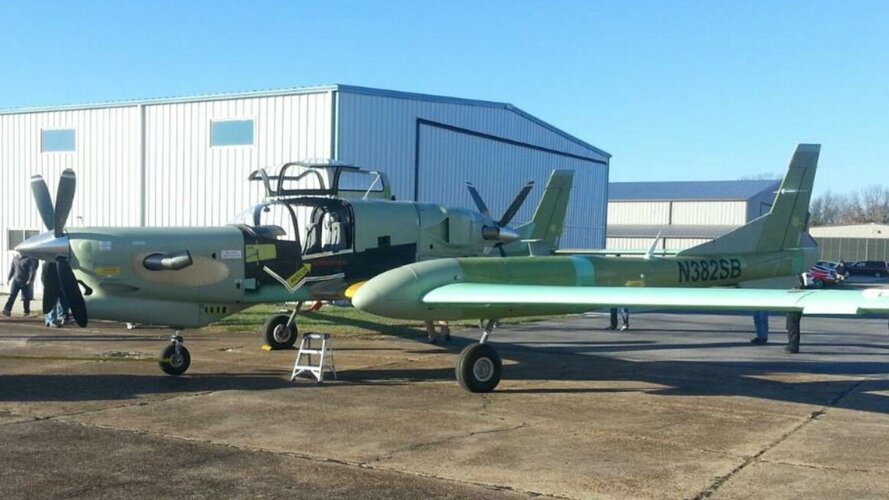
Source: https://www.linkedin.com/posts/kevi...r-aircraft-activity-6389631563683889152-N8Tl/
More about the SA-338B:
Source: https://www.airframer.com/news_story.html?release=9750The SA-338B Shadow Hawk aircraft is a two or three-seat, fixed gear, low wing, twin boom aircraft. The SA-338B aircraft is designed to fly slowly along a coastline at an altitude of about 1,500 to 2,000 feet. Its primary mission applications include border protection, counter drug activities, intelligence collection against regional instabilities, fisheries patrol, environmental monitoring, and search and rescue. Sikorsky is marketing the SA-338B to the United States Coast Guard and the Department of Homeland Security.
It would appear (notably from the various comments on the LinkedIn page I mentioned further up) that assembly started in 2010 and that 150 hours or PT6A ground tests were performed, but that the project was abandoned before the aircraft could fly. Also it is more than likely that the second airframe was never completed and that the registration reserved [N385SB] was never actually used.
- Joined
- 25 June 2009
- Messages
- 14,731
- Reaction score
- 6,069
As requested, I'm doing a simplified version of my Sikorsky list here. By "simplified", I mean there will be no detailed account of quantities, production batches, registrations or construction numbers for the larger production models. For the time being, I'll tackle only the S-29 through S-51 types (the rest will be done eventually). Note that I have also included the prototypes and projects that didn't garner a proper "S-" designation.
(to be continued)
(to be continued)
Last edited:
- Joined
- 25 June 2009
- Messages
- 14,731
- Reaction score
- 6,069
Last edited:
- Joined
- 25 June 2009
- Messages
- 14,731
- Reaction score
- 6,069
I would love to present you with a definitive list of Igor Sikorsky's Russian aircraft... Unfortunately, it seems like no two sources seem to agree on the allocation of certain designations...
- According to some, the "Krugliy" monoplane was the S-9, with its "Polukrugliy" derivative being the S-11. However, other sources give the "Krugliy" as the S-11, and the "Polukrugliy" as the S-11A.
- According to some, the "Grand" airliner was the S-9, while others give it as the S-21.
- The IM series was divided into 7 main versions, designated IM-A, IM-B, IM-V, IM-G, IM-D, IM-E and IM-J (following the order of the Cyrillic alphabet); however, the Sikorsky Archives website (contrary to the other sources) doesn't mention an IM-A version as such, and divides the others into sub-versions as IM-B/IM-B', IM-V/IM-V', IM-G/IM-G', IM-D/IM-D'. That wouldn't be such a problem in itself, but while most sources agree that IM-A was S-22, and that all IM-B and IM-V aircraft were S-23, the Archives give the B/B' series as S-22 and S-22A, and the V/V' series S-23 and S-23A. Other sources still have grouped IM-A and IM-B under S-22, with S-23 being only for IM-V...
- While most sources seem to agree that the G series was divided into S-24 (G-1) and S-25 (G-2/G-3), the breakdown and production numbers for each differ dramatically. Also, the Archives call the S-24 as just G and the S-25 as G'.
- Many sources give the D and E series as being S-26 and S-27, respectively. The Archives doesn't mention an E version; instead they give the D as S-26, and the D' as both S-26 and S-27... Other sources still consider D and E to be S-25 and S-26, with S-27 being the unbuilt J series...
- Joined
- 6 September 2006
- Messages
- 4,829
- Reaction score
- 9,424
Not so long back there was a lengthy argument in an Air Britain forum about whether the WS-51 ever was officially the WS-51. I believe it was confirmed that the manufacturer's data plates were actually stamped S-51.Westland WS-51 DRAGONFLY.
I'll have to dig out the thread.
Aeroweanie
ACCESS: Confidential
- Joined
- 1 May 2020
- Messages
- 95
- Reaction score
- 263
I have finally worked out what the mysterious "Sikorsky SZ 338B" was ! Since the former Schweizer SA 2-38B Shadowhawk (RU-38B Twin Condor), became the Sikorsky SA-38B, I had a hunch, that the former SA 3-38B could be it... and after looking specifically for that particular model, it turned out that I was right: Kevin Hritz, Senior Principal Electrical Engineer at Sierra Nevada, who worked from 2006 to 2012 for Sikorsky Aircraft as Senior Electrical/Avionics/Systems Engineer, posted a photo of [N382SB] on his profile (the only one I've ever seen), and designated it as the "Sikorsky (Schweizer) SA 3-38B MCSA ISR Aircraft, powered by PT6A-34 engines."
View attachment 756189
Source: https://www.linkedin.com/posts/kevi...r-aircraft-activity-6389631563683889152-N8Tl/
More about the SA-338B:
Source: https://www.airframer.com/news_story.html?release=9750
It would appear (notably from the various comments on the LinkedIn page I mentioned further up) that assembly started in 2010 and that 150 hours or PT6A ground tests were performed, but that the project was abandoned before the aircraft could fly. Also it is more than likely that the second airframe was never completed and that the registration reserved [N385SB] was never actually used.
Finally! I saw a model of this in someone's office and got him to tell me the whole gory story.
Similar threads
-
-
-
-
-
Sikorsky Long-Range Hybrid-Electric VTOL Demonstrator (HEX)
- Started by VTOLicious
- Replies: 5

